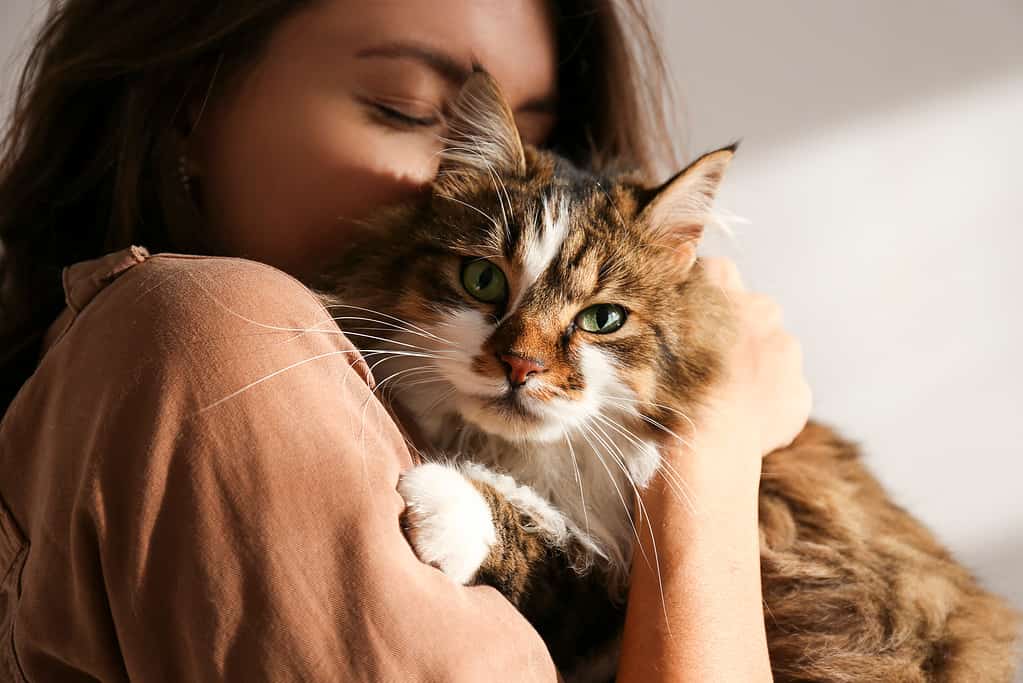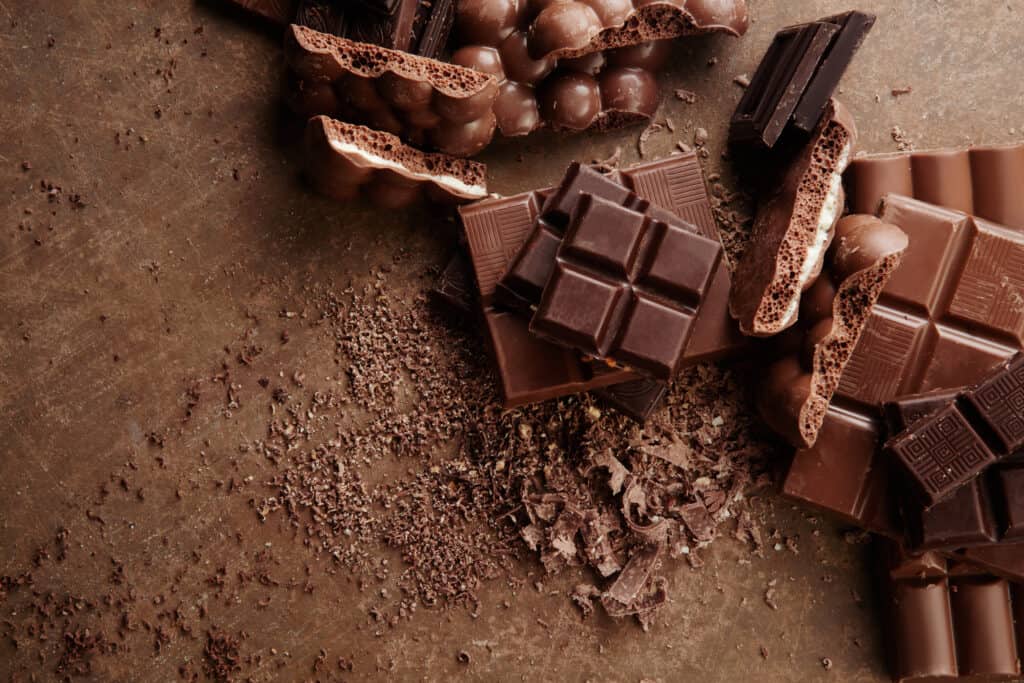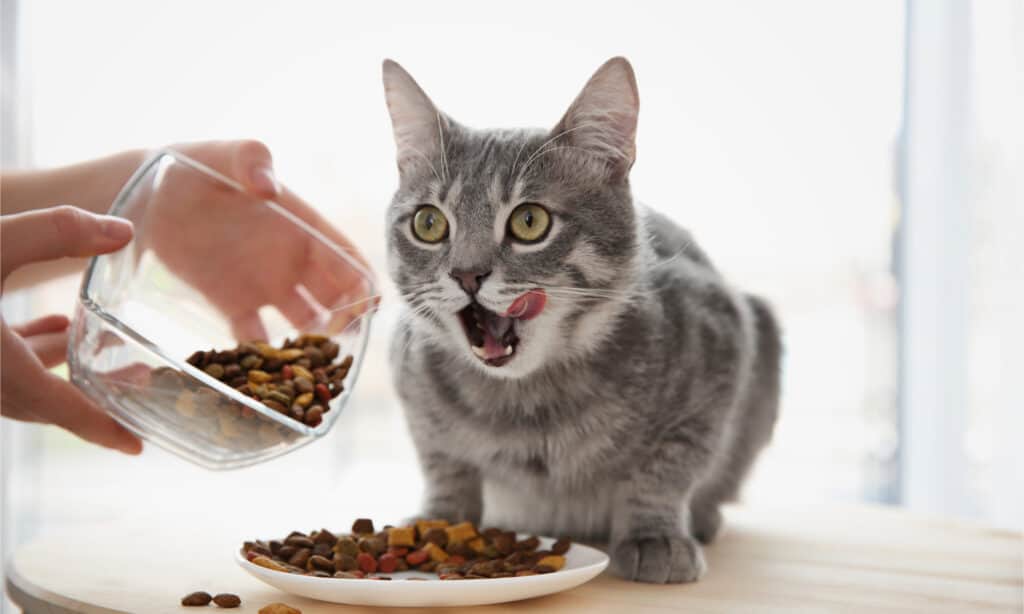You may have heard that chocolate is toxic to cats, but also that it isn’t as toxic as some people make it out to be. While it’s true that there are more toxic substances–like onions–that are talked about less, chocolate can still kill a cat if they eat enough of it.
It may take as little as 20 mg of theobromine, the toxic substance in chocolate, per kg of body weight to cause symptoms of poisoning in a cat. By the time they eat 40-100 mg per kg of body weight, they’re looking at more severe symptoms such as cardiac issues, seizures, coma, or death.
A 12-pound cat who eats just 8 grams (0.3 ounces) of unsweetened baker’s chocolate should be brought in for emergency veterinary treatment. The same-sized cat eating milk chocolate should see an ER vet if they eat 50 grams (1.8 ounces) or more.
In this article, we’ll discuss whether cats can eat chocolate, which types of chocolate are most dangerous to cats, and how much chocolate it takes to poison a cat.
How Much Chocolate is Toxic to a Cat?

Different cats respond differently to chocolate poisoning.
©savitskaya iryna/Shutterstock.com
How much chocolate your cat can eat without getting sick (or dying) depends on the type of chocolate they eat and their weight.
The toxic substance in chocolate is called theobromine. Chocolate also contains caffeine, which is toxic to cats as well, but in smaller amounts. The toxic dose of theobromine is 100-200 mg per kg of body weight. However, according to Merck’s Veterinary Manual, sensitivity to these toxins varies, and some animals will experience poisoning or fatality after eating much less.
They advise that, in dogs, doses as low as 20 mg/kg can cause mild symptoms, while 40-60+ mg can cause severe symptoms or death. It’s always best to err on the side of caution when it comes to your pet’s health, so I would follow the same guidelines for cats as well.
Merck’s calculator for chocolate poisoning also seems to say that toxic amounts are the same for cats vs. dogs.
Cocoa powder and chocolate used for baking are the most dangerous, containing 14 mg of theobromine per gram. It can take as little as ½ an ounce of these types of chocolate to cause severe poisoning and death, and cats who eat less may still suffer from poisoning.
Next up is semisweet dark chocolate at 5 mg, then milk chocolate at 2 mg. White chocolate contains very little theobromine and isn’t nearly as dangerous.
Symptoms of Chocolate Poisoning in Cats
Symptoms from eating chocolate can range from mild to severe. Remember that each cat will react differently to chocolate, so some may have much more severe reactions even after eating the same amount.
You’ll usually notice symptoms around 6-12 hours after your cat eats chocolate. Possible symptoms are as follows:
- Vomiting
- Diarrhea
- Swollen abdomen
- Restlessness
- Increased thirst and urination
- Hyperactivity
- Poor muscle control and difficulty walking
- Rigidity
- Tremors or seizures
- Tachycardia (increased heart rate)
- Premature ventricular contractions
- Rapid breathing
- Blue skin, especially seen around the mucous membranes
- High blood pressure
- Hyperthermia
- Bradycardia (slowed heart rate)
- Low blood pressure
- Coma
- Hypokalemia (low blood potassium)
Cats who die of chocolate poisoning may die due to cardiac arrhythmias (abnormal heart rate), hyperthermia, or respiratory failure. Cats who eat chocolate may also suffer from or die of pancreatitis, which is inflammation of the pancreas that can be caused by eating fatty foods.
What to do if Your Cat Eats Chocolate

Even small amounts of chocolate can kill a cat, so always call your veterinarian or a pet poison hotline for help.
©evrymmnt/Shutterstock.com
If your cat eats chocolate, please call a pet poison hotline or your veterinarian. Let them know your cat’s weight, the type of chocolate, and how much they’ve eaten. If it’s after hours, you may need to visit an emergency vet clinic for treatment.
While you shouldn’t panic, it’s important not to underreact, either. Each cat reacts differently to chocolate, so it’s better to be safe than sorry.
While you likely won’t need the vet for just a small lick, I’d see the vet for anything beyond this. Just 14 grams of baking chocolate or cocoa powder can kill your cat, and less than this can still have negative impacts.
Avoid home remedies such as making your cat vomit to remove the chocolate from their system. This can be dangerous if not done by a professional, and you may cause more harm to your cat by doing so.
Your veterinarian may induce vomiting if you bring them in soon enough after your cat eats the chocolate. This is going to be the best thing for them, as waiting for symptoms will mean the toxins have already been absorbed.
Depending on the severity of the poisoning, your vet might keep your cat hospitalized where they can offer them IV fluids and medications, and keep a close eye on them to give them the best odds of recovering.
Is Any Chocolate Safe for Cats?

Avoid feeding your cat chocolate and chocolate-flavored foods.
©ivan_kislitsin/Shutterstock.com
No, your cat should never eat any type of chocolate! While some types, such as milk chocolate, have less theobromine, it can still poison your cat and potentially kill them.
Please never feed cats chocolate on purpose. Even if you’ve already done so in the past and they’ve been fine, there’s no guaranteeing they won’t have a bad reaction next time.
Chocolate-flavored foods such as ice cream and other desserts are also dangerous. While the chocolate may be more diluted in these foods, it’s still not safe to feed them to your cat.
They may also be harmful for other reasons. For instance, ice cream itself is bad for cats as they’re lactose intolerant–the myth that they should be fed milk is just that, a myth!
Many desserts are also high in fat, which can cause pancreatitis. Pancreatitis is an emergent condition that causes swelling of the pancreas and can be fatal.
Safe Foods for Cats

The safest food for your cat is their own cat food, but you can feed scraps of cooked, unseasoned meats as treats!
©Africa Studio/Shutterstock.com
Your cat’s primary diet should consist of a quality cat food. If you can afford it, canned food is better than kibble as it contains fewer carbs and more moisture. Though raw food is growing in popularity, I won’t feed it to my own cats since the Federal Department of Agriculture (FDA) and the American Veterinary Medical Association (AVMA) both recommend against it.
Too much human food in a cat’s diet can cause health issues. They may become overweight or get the wrong balance of nutrients.
When feeding the occasional treat, remember that cats can’t taste sweet–so you really don’t need a replacement for chocolate in that way.
If you do want a cute alternative, Purina makes treats shaped like chocolate bars! I give these to my senior cat as a treat for taking his medications, and he loves them.
Cats are also obligate carnivores, so the best treats for them are small scraps of cooked, unseasoned meat like turkey, chicken, and salmon. Avoid seasoned meats, as some common seasonings can be toxic.
Keeping Cats From Eating Chocolate
Some cats can be pretty mischievous, and you may have trouble keeping them from eating things they shouldn’t. Always make sure to put chocolate and items containing it out of reach.
If your cat likes to open cupboards, childproof cabinet locks can help. It’s especially important to lock up your baking supplies and dark chocolate since these are the most toxic.
Keeping your chocolate in the fridge is another option. This can also stop your chocolate from melting in the heat! Personally, I love a cold chocolate bar on a hot day.
While you’re baking or have toxic foods out on the counters, you may need to keep your cat out of the kitchen with a door or baby gate (if they don’t jump over them). Never leave chocolate unattended, and always clean up once you’re done eating.
If you have children, make sure they aren’t leaving chocolate candy or cookies in your cat’s reach either. You may need to have them sit at the table when eating snacks that are dangerous to cats so that you can manage the situation.
Once, my cat got into some Oreos that a family member had eaten the cream from and left in the living room! Luckily he only got a couple of licks before they were taken away, but he did get a taste for chocolate that day and will still try to sneak chocolate even years later.
So, if you have a kitty like this, I feel your pain!
Thank you for reading! If you have feedback on this post, please contact the AZ Animals editorial team.
The photo featured at the top of this post is © iravgustin/Shutterstock.com
Thank you for reading! Have some feedback for us? Contact the AZ Animals editorial team.






